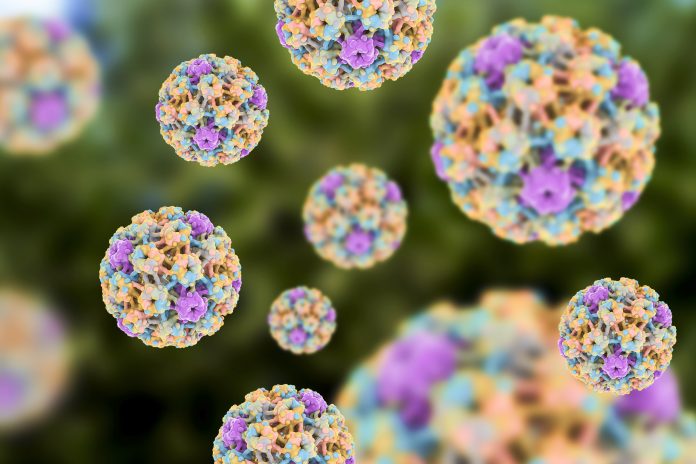
Changes in the diversity of human papillomavirus (HPV) types following vaccination may affect future cervical cancer screening programs, suggests data from a study of different vaccination strategies among communities in Finland.
The study’s lead author, Ville Pimenoff, from the Karolinska Institutet in Stockholm and Oulu University in Finland, told Inside Precision Medicine that the study demonstrates the efficacy of HPV vaccination for the prevention of cancer-causing HPV infections, particularly when both boys and girls are vaccinated.
“Moreover, based on our observations when up to 50% (or more) of the young age groups are HPV-vaccinated, the HPV-related cancer screening protocols should be adapted to recognize the increased distribution of vaccine-untargeted HPVs with low or no risk for cancer progression,” he said. “Otherwise, screening can lead to overdiagnosis of individuals who are not at risk of cancer, and unnecessary testing and treatment that would be a burden for the patient and the healthcare system.”
There are over 200 different types of HPV, of which 12 (types 16, 18, 31, 33, 35, 39, 45, 51, 52, 56, 58, 59) are defined as oncogenic in humans. According to the World Health Organization,1 HPV16 and HPV18 are jointly responsible for 71% of cervical cancer cases worldwide and all vaccines for the prevention of HPV-related disease target these two types. There is also a quadrivalent vaccine that additionally targets HPV types 6 and 11 to protect against anogenital warts, and a nonavalent that protects against types 6, 11, 16, 18, 31, 33, 45, 52 and 58.
To date, 125 (64%) countries have introduced the HPV vaccine in their national immunization program for girls, and 47 (24%) also vaccinate boys.
The first HPV vaccine was licensed in 2006 and for the last decade epidemiologists have tried for a decade to test if HPV vaccination is evolution proof, Pimenoff explained. “That is, to show if HPVs viral population will eventually respond or not to the cleared HPV niche caused by the vaccine targeting only a few strains of the circulating HPVs population.”
Pimenoff researches the ecology and evolution of human infecting pathogens and when he realized that no one had comprehensively tested the oncogenic HPV type replacement at the level of ecological diversity in a sufficiently large community-randomized HPV vaccination trial, he decided to investigate.
His team performed an eight-year follow-up study of 33 communities in Finland that were randomly assigned to vaccinate both girls and boys against HPV16/18, to vaccinate girls only, or to offer no HPV vaccination to either girls or boys.
The study included children born between 1992 and 1994 who were followed up at the age of 18 (n=11,396) and 22 (n=5602) years, representing four and eight years after vaccination. Cervicovaginal samples were genotyped for HPV types 6, 11, 16, 18, 31, 33, 35, 39, 45, 51, 52, 56, 58, 59, 66, and 68 to estimate the ecological diversity of the virus types. The vaccine coverage rate was moderate, at up to 50%.
The results, reported in Cell Host & Microbe show that 8 years after vaccination, the prevalence of HPV types 16 and 18 declined significantly in the 22 towns in which the vaccine was provided. In the 11 towns that vaccinated girls and boys, there was also a decrease in both HPV 31 and HPV 45, whereas only HPV 31 declined in the towns that vaccinated girls but not boys.
“This shows that you get stronger herd immunity if you vaccinate both boys and girls,” said Pimenoff. “According to our calculations, it would take 20 years of vaccinating girls to achieve the same effect that can be achieved in eight years with a relatively moderate vaccination coverage rate of gender-neutral vaccination.”
The researchers also demonstrated that the virus types eliminated by the vaccine were replaced by other HPV types of low oncogenicity, a claim that was once moot but that has now, say the researchers, been confirmed. Specifically, they observed a significant increase of non-vaccine-targeted HPV types 52 and 66 among the gender-neutral communities relative to the control communities and a significant increase in HPV type 52 among the gender-neutral compared with girls-only communities.
This means that although the risk of cancer from the virus types against which the vaccine protects is negated, but the risk for cancer per se is not eliminated, since they are replaced by low-risk virus types.
Piemenoff and co-authors comment: “This likely sign of niche occupation by the non-vaccine-targeted HPVs will potentially affect the future cervical cancer screening programs but should not interfere with the WHO mission to eliminate cervical cancer.”
Piemenoff added: “The HPV vaccine is effective against the high oncogenic HPV types and studies, including our own, show that there is no reason to be concerned about the observed increase of low oncogenic HPV types since they very rarely cause cancer.”
The researchers now plan to analyze samples taken from the participants up to 16 years after the vaccination to better understand the long-term diversity pattern of the remaining HPV types. They are also looking into the methylation patterns of the host and HPVs among these women to determine whether there is a difference between the remaining low-risk HPV infections post-vaccination.
- World Health Organization (December 2022). “Human papillomavirus vaccines: WHO position paper (2022 update)”. Weekly Epidemiological Record. 97 (50): 645–672.












